Massage Therapy
Deep Tissue Massage
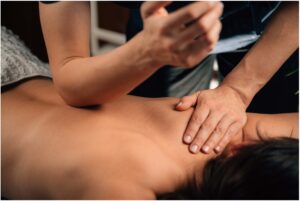
Deep tissue massage therapy is a type of massage that targets the deeper layers of muscles and connective tissues. Although it is similar to Swedish massage, this technique involves slow and deep pressure to specific areas of the body, focusing on areas with tension, stiffness, or chronic pain. The main benefits of deep tissue massage therapy include:
- Pain relief: Deep tissue massage can help reduce chronic pain by releasing tension and breaking down scar tissue.
- Improved mobility: By releasing the tension in contracted muscles and increasing blood flow to the area, deep tissue massage can help improve flexibility and range of motion.
- Release muscle tension: Deep tissue massage can have a calming effect on the body and mind, reducing stress and improving circulation.
- Deep tissue mass is the perfect choice for anyone seeking to release oflayers of tension.”
The frequency with which you should get a deep tissue massage depends on various factors, such as your overall health, the reason you are getting a massage, as well as your personal preferences and circumstances. For general wellness, many people find that getting a deep tissue massage once a month helps to alleviate stress and tension in the muscles.
If you are recovering from an injury or have chronic pain, you may benefit from more frequent sessions, such as once a week or every other week, depending on the severity of your condition and your doctor's recommendations.
However, it's essential to listen to your body and communicate with our massage therapists. They can advise you on the best frequency of massage for your needs.
It's common to feel sore after a deep tissue massage. Soreness generally occurs a day or two after the massage, and it can last for up to 48 hours.
However, the level of soreness can vary from person to person, depending on various factors such as their pain tolerance, the intensity of the massage, and their general physical condition.
To minimize post-massage soreness, it's recommended that you drink plenty of water after the massage to avoid dehydration, rest and refrain from any strenuous activities for at least 24 hours, and apply ice packs to the sore areas.
Swedish Massage

Relaxation Massage, commonly known as “Swedish Massage,” is a widely preferred type of classic massage treatment. Research at Stanford University reveals that stress is the root cause of 95% of all illnesses. Relaxation massage is to alleviate stress by utilizing light to firm pressure techniques on the surface layers of muscles. Relaxation massage is highly recommended for first-time clients, providing excellent benefits such as promoting circulation and flexibility while easing muscle tensions.
Light pressure is applied to the muscles, tendons, and ligaments throughout the body, promoting relaxation and reducing stress. Relaxation massage can also help loosen tightness and scar tissue, increase flexibility and range of motion, and relieve pain and stiffness.
Some potential benefits of Swedish massage include reducing anxiety and depression, improving sleep quality, boosting immune function, and enhancing overall well-being and quality of life. It is best recommended for people who seek general relief.
It is designed to help promote relaxation, reduce stress and tension, and improve blood circulation. Swedish massage is an excellent choice for anyone looking for a relaxing and soothing massage experience, regardless of their physical condition. It is particularly beneficial for people who:
– Have muscle stiffness or soreness due to a sedentary lifestyle or sitting at a desk for long periods
– Are recovering from an injury or surgery and need a gentle massage that promotes healing
– Have conditions such as arthritis, fibromyalgia, or tension headaches, as Swedish massage can help reduce pain in these conditions.
Swedish massage here at Inspire, is a great option for anyone who wants to enjoy a calming, gentle massage experience.
Yes, Swedish massage can help with stress reduction. One of the main benefits of Swedish massage is its ability to promote relaxation and reduce muscle tension, both of which can significantly help individuals manage their stress.
Swedish massage has also been found to reduce the levels of cortisol, a hormone associated with stress, in the body. Several studies have suggested that Swedish massage can be effective for reducing symptoms of anxiety and depression, as well as improving overall mood.
Swedish massage can be an excellent way to help manage stress and promote relaxation.
Myofascial Release Therapy
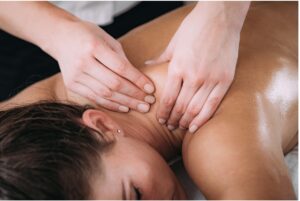
Myofascial release therapy is a manual technique used to alleviate pain and tension in the body’s connective tissue, also known as fascia. Myofascial release involves applying gentle sustained pressure to specific areas of the muscle, allowing it to relax and release tension that may be causing discomfort or limiting mobility.
The benefits of myofascial release therapy helps reduce pain and tension, improves range of motion, increases circulation, aligns posture and decreases risk of injury. It is perfect treatment for clients with limited mobility, clients prone to migraines, athletes, and clients who experience chronic body fatigue and pain.
Myofascial release therapy can be painful in some cases, but it is not always the case. Myofascial release therapy involves applying pressure to the myofascial tissues, which can cause discomfort or pain at the site of tension or restriction. However, the intensity of the pressure can be adjusted to minimize the discomfort.
If the therapist applies too much pressure, or if the area being worked on is very tender or sensitive, the patient may experience pain. However, our experienced myofascial release therapists are trained to work within a patient's comfort level and to monitor their response to pressure to prevent excessive discomfort or pain.
Some patients may experience tenderness or soreness after his/her appointment, but this is often a normal and expected result of the treatment. This tenderness usually resolves within a few days, and some patients report feeling an increased range of motion and reduced pain and tension as a result of the treatment.
Myofascial release therapy should not be excessively painful, and the therapist will work with the patient to ensure that the pressure is appropriate and not causing excessive discomfort.
Myofascial release therapy can sometimes cause bruising, but it is not a common or expected side effect. Bruising may occur if too much pressure is applied to the tissue, or if the tissue is particularly sensitive or fragile.
If a patient is concerned about the risk of bruising or has a tendency to bruise easily, they should talk to their massage therapist before the session to discuss any potential risks and to ensure that the pressure is appropriate for their individual needs.
Cupping Therapy
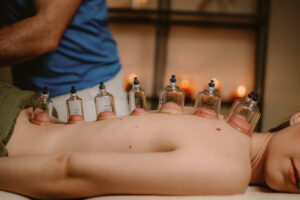
Cupping therapy can feel differently for different individuals and depend on the type of cupping therapy used. However, most people describe cupping therapy as a sensation of tightening and pulling of the skin in the area of application.
During fire cupping, which is the most common type, the cups are placed on the skin and air is suctioned out to create a tight seal. Some people may also feel warmth or a slight burning sensation.
Hot Stone Massage

There is a possibility that hot stones could burn your skin if the temperature is too high or if they are left in one place for too long. However, trained professionals who provide hot stone therapy will take great care to ensure that the stones are used at a safe temperature and moved frequently to avoid any skin damage. If you have concerns, be sure to communicate with your therapist and inform them of any discomfort during the session.
Pregnancy Massage
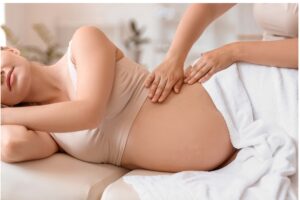
Pregnancy massage therapy can have several benefits for expecting mothers, including:
– Reducing stress and anxiety
– Relief from muscle tension and aches
– Improving circulation
– Limiting risk of pregnancy complications
It is important to note that while massage can offer many benefits, it should never be a substitute for regular medical care during pregnancy. Additionally, it is important to work with our licensed and experienced massage therapists who have specialized training in pregnancy massage at Inspire!
You might lie on your side with the support of pillows and cushions. Or our therapists will make accommodations with our special pregnancy cushion that allow you to lie face down safely, while providing room for your growing belly and breasts.
Paediatric Massage
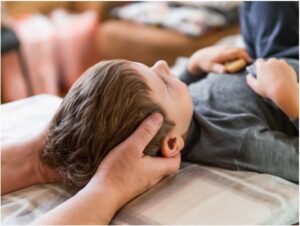
Paediatric massage therapy is a form of massage specific for infants and children. It is a gentle and soothing technique that can help children relax, sleep better, improve digestion, and reduce stress. Paediatric massage therapy can also have a positive impact on children with medical conditions such as asthma, diabetes, and autism spectrum disorders. In addition, it can strengthen caregiver-child bonding and help children develop a healthy sense of touch and body awareness. Children who have trouble sleeping, experience stress and muscle fatigue would benefit greatly from paediatric massage therapy.
Our RMT Team at INSPIRE aim to help you live without the fear of pain and injury.
Our Patient Review
"Curabitur accumsan felis in dui placerat lobortis. Pellentesque et malesuada orci, quis pretium neque. Aenean accumsan sodales tortor, porta tempor nunc efficitur quis. Nunc sit amet magna ac dui aliquet euismod nec vitae nisi."
"Curabitur accumsan felis in dui placerat lobortis. Pellentesque et malesuada orci, quis pretium neque. Aenean accumsan sodales tortor, porta tempor nunc efficitur quis. Nunc sit amet magna ac dui aliquet euismod nec vitae nisi."
"Curabitur accumsan felis in dui placerat lobortis. Pellentesque et malesuada orci, quis pretium neque. Aenean accumsan sodales tortor, porta tempor nunc efficitur quis. Nunc sit amet magna ac dui aliquet euismod nec vitae nisi."

